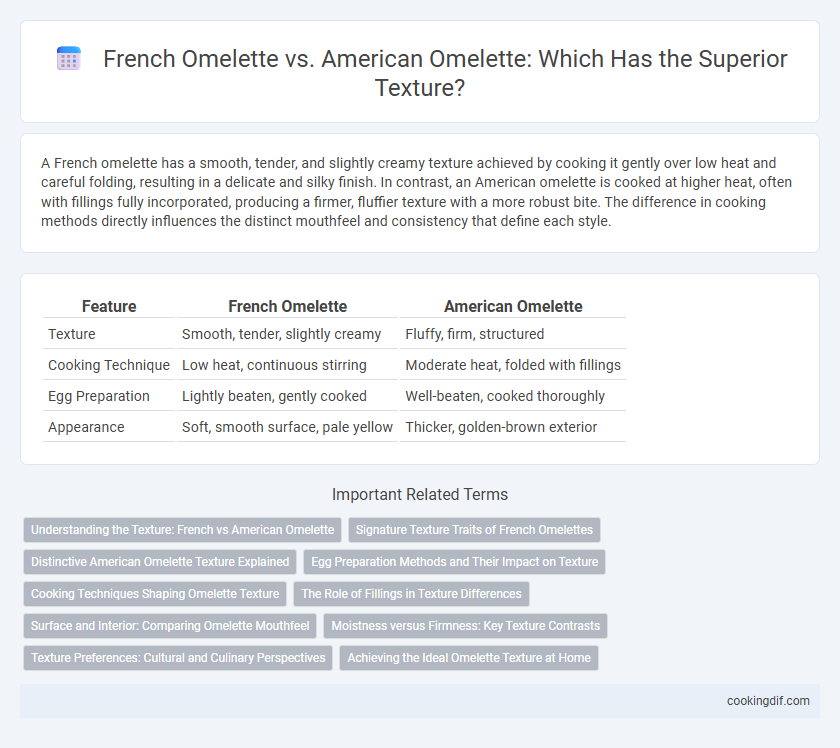A French omelette has a smooth, tender, and slightly creamy texture achieved by cooking it gently over low heat and careful folding, resulting in a delicate and silky finish. In contrast, an American omelette is cooked at higher heat, often with fillings fully incorporated, producing a firmer, fluffier texture with a more robust bite. The difference in cooking methods directly influences the distinct mouthfeel and consistency that define each style.
Table of Comparison
| Feature | French Omelette | American Omelette |
|---|---|---|
| Texture | Smooth, tender, slightly creamy | Fluffy, firm, structured |
| Cooking Technique | Low heat, continuous stirring | Moderate heat, folded with fillings |
| Egg Preparation | Lightly beaten, gently cooked | Well-beaten, cooked thoroughly |
| Appearance | Soft, smooth surface, pale yellow | Thicker, golden-brown exterior |
Understanding the Texture: French vs American Omelette
French omelettes have a smooth, tender, and slightly creamy texture achieved by gently cooking beaten eggs over low heat and carefully folding them, resulting in a delicate, custard-like interior. American omelettes are cooked at higher heat, often fully set and firmer, with fillings like cheese, vegetables, or meats folded inside, creating a fluffy and hearty texture. The key difference lies in the cooking technique, with the French method prioritizing softness and silkiness, while the American style emphasizes volume and a more substantial bite.
Signature Texture Traits of French Omelettes
French omelettes are characterized by their smooth, tender, and slightly creamy texture, achieved through gentle folding and minimal browning during cooking. In contrast, American omelettes are often thicker and more densely cooked, with a firmer and fully set interior. The signature texture of French omelettes emphasizes a delicate, custard-like consistency that melts effortlessly on the palate.
Distinctive American Omelette Texture Explained
The American omelette features a thicker, fluffier texture achieved by whisking eggs vigorously and cooking at a moderate heat to create a more substantial body. In contrast, the French omelette has a smooth, delicate, and slightly custardy texture, emphasizing minimal browning and gentle folding. This distinctive American omelette texture results from incorporating baking powder or additional air, offering a heartier bite compared to the creamy softness of the French style.
Egg Preparation Methods and Their Impact on Texture
French omelettes utilize beaten eggs cooked gently over low heat, resulting in a smooth, tender texture with a slightly creamy interior, achieved by continuous stirring and folding. American omelettes employ fully beaten eggs cooked over moderate heat without stirring during cooking, creating a firmer, more set texture with a slightly browned exterior. The differing egg preparation methods--gentle heat and stirring for French versus steady heat and no stirring for American--directly impact the omelette's moisture retention and texture profile.
Cooking Techniques Shaping Omelette Texture
French omelettes feature a tender, silky texture achieved through gentle folding and low heat cooking, preserving a slightly creamy interior. American omelettes rely on higher heat and thorough mixing, resulting in a firmer, fluffier texture with fully cooked eggs. Mastering these distinct cooking techniques is key to shaping the unique textures characteristic of each omelette style.
The Role of Fillings in Texture Differences
French omelettes feature a soft, creamy texture achieved through minimal fillings like fine herbs or cheese, which allow the eggs to remain tender and slightly runny. American omelettes incorporate heartier fillings such as vegetables, meats, and cheeses, resulting in a denser, more substantial texture that curves the eggs into a firmer structure. The quantity and type of fillings significantly influence the moisture content and firmness, distinguishing the silky consistency of French omelettes from the robust texture characteristic of American versions.
Surface and Interior: Comparing Omelette Mouthfeel
The French omelette features a smooth, tender surface with a creamy, slightly runny interior, creating a delicate mouthfeel that melts effortlessly on the tongue. In contrast, the American omelette has a firmer, browned exterior and a fully cooked, fluffy interior, offering a more robust and structured texture. This difference in surface and interior textures defines the distinct sensory experience between the silky French style and the hearty American preparation.
Moistness versus Firmness: Key Texture Contrasts
French omelettes are renowned for their smooth, tender texture, characterized by a moist and slightly runny interior achieved through gentle folding and minimal cooking. In contrast, American omelettes are cooked longer to create a firm, fully set exterior with a fluffy, dense texture that holds fillings more robustly. The key texture contrast lies in the French style's emphasis on delicate moistness versus the American preference for a sturdy, well-cooked firmness.
Texture Preferences: Cultural and Culinary Perspectives
The French omelette is renowned for its smooth, tender texture achieved through gentle folding and minimal browning, creating a delicate, custard-like interior. In contrast, the American omelette features a firmer, fully cooked texture with browned edges and a fluffy, slightly denser interior due to more vigorous stirring and folding techniques. These texture preferences reflect cultural culinary values: French cuisine emphasizes refinement and subtlety, while American cooking favors heartiness and robustness.
Achieving the Ideal Omelette Texture at Home
The French omelette achieves a tender, silky texture by gently cooking beaten eggs over low heat and softly folding them to maintain a smooth, slightly runny interior. In contrast, the American omelette features a firmer, fully cooked texture with a fluffy, well-structured body created by vigorous whisking and cooking at higher heat. Mastering temperature control and folding techniques is essential to replicate these classic textures and enjoy the perfect omelette at home.
French Omelette vs American Omelette for texture Infographic

 cookingdif.com
cookingdif.com